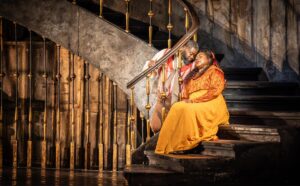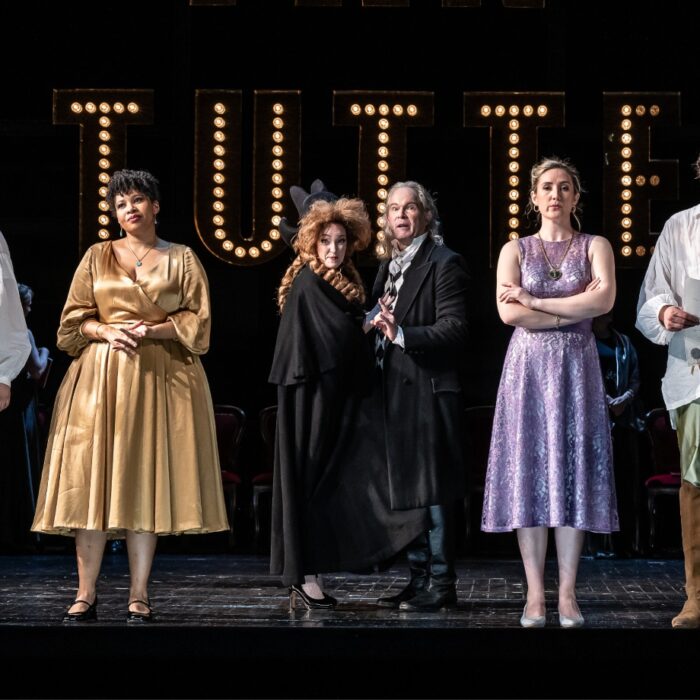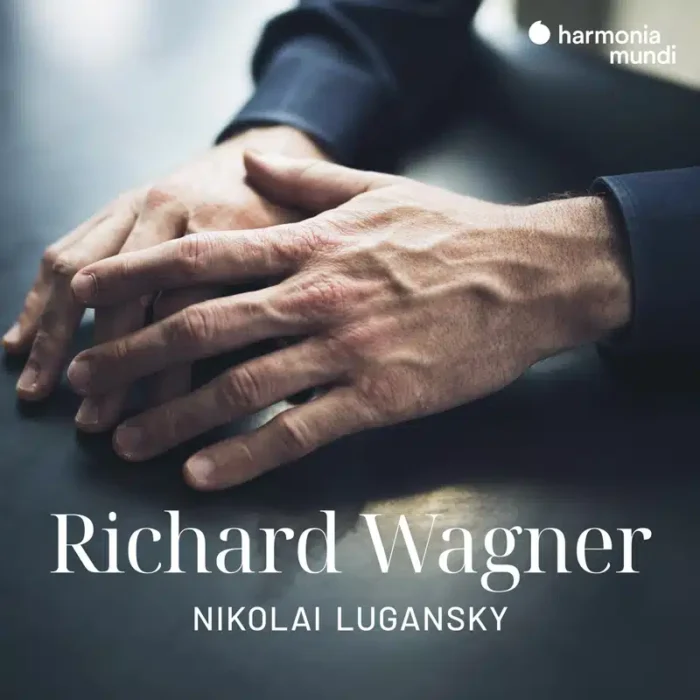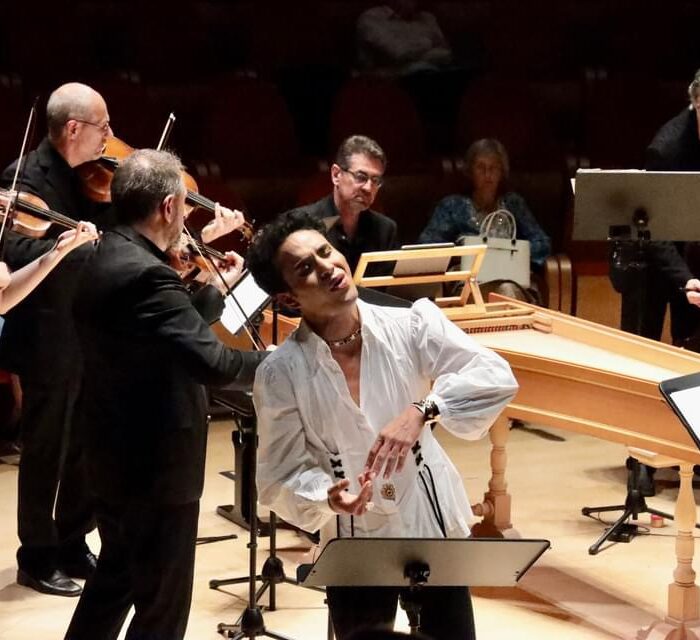
Royal Opera House 2023-24 Review: Tosca
Soprano Angel Blue & Tenor Russell Thomas Lead Breathtaking Revival
By Mike Hardy(Photo: Tosca © ROH 2024)
One of the more frequent criticisms aimed at opera singers, by those not acquainted in any way with the art form, pertains to what it is, exactly, they do other than sing. In OperaWire’s interview with the Cavaradossi of this production, Russell Thomas, the tenor said of many critics: “it’s a career that everybody who can never DO what it is that we do, has an opinion about what it is that we do.”
Had those critics been afforded the opportunity to hear and see, firstly, the FIRST day of rehearsals at the Royal Opera House for “Tosca,” and then its opening night, then their curiosity would have been more than satisfied.
Illuminating Revival Details
On that first day rehearsal, I witnessed star soprano Angel Blue receiving instruction from the stunt co-ordinator with regards how to breakfall from the obligatory leap to her death from the Castel Sant’Angelo at the cessation of the opera. It was clear that this production required her to forego the usual, gentle forward step into the abyss, (and onto the hidden, bountiful, generous soft cushions beneath), and instead to attempt a far more dramatic BACKWARDS leap. Despite much instruction from the co-ordinator, who proceeded to demonstrate seated on the stage; chin on chest, arms at waist level, gentle fall backwards…..it was clear that the star soprano seemed none too enthusiastic, and at the end of the full rehearsal itself, the curtain fell without her making any attempt to make it.
So much did I perceive her consternation, that I had reservations about whether she would attempt the leap at all, or that it would have to be reverted to the more traditional forward step. I write this superfluous account of it only because on opening night, Angel Blue effected one of the most spectacular, acrobatic, dramatic and heart-stopping backwards falls I would respectfully suggest has ever been witnessed in any “Tosca” performance. Not just a fall but a pronounced leap, limbs akimbo, making clear horizontal progress before plummeting downwards. It was literally, breathtaking.
Of course, there was much drama and events to unfold before this most memorable of cessations in this Peter Relton revival of Jonathan Kent’s original. Designer Paul Brown’s sets were wonderfully atmospheric and impactive, not least because of Mark Henderson’s searing light creations which served to intensify the mood by highlighting key components of the set: The first act Church of Sant’ Andrea Della Valle, austere in its quasi darkness, yet vibrant in the cleverly placed fills and spots lights. The towering ‘Madonna’ statue taking centre stage with elaborate, gilded staircases to either side with a scaffolded section towards the front to facilitate access Cavaradossi’s painting of Mary Magdalene, with dark corners accented and accentuated by candlelight.
An even MORE impressive statue takes centre stage for the second act in Scarpia’s apartment within the Palazzo Farnese, a huge, most realistic depiction of Archangel Michael slating Satan, somewhat ironic given the devil incarnate whose office and dwelling it shared. These two acts, act one and two, representative of Rome’s cornerstones of power, the church and the palace. The THIRD cornerstone of Rome’s power being prison, the setting for act three where our intrepid hero, Cavaradossi, awaits his demise and from the walls of where our heroine makes her afore-mentioned impressive leap to her doom.
Musical Highlights
American soprano Angel Blue’s talents are clearly not limited to aerial acrobatics. She possesses a fine instrument. There was a propensity for some shrillness and loss of definition in the extreme upper registers, and I detected a slight loss of composure in the melodramatic cries in the score, especially on discovering that her lover has genuinely been shot, but in general she sings with a remarkable beauty, especially when lowering the intensity of her volume. Her interactions with Cavaradossi in the church were most endearing, coquettish and charmingly naïve. When she requests Cavaradossi to paint the eyes of the girl in his portrait dark, singing “Ma falle gli occhi neri!” she flutters her eyes comedically.
But these impish, girlish characteristics are quickly swapped for mournfulness and retribution seeking on being told her lover may have other romantic interests, in her first meeting with Scarpia. Her voice adopts a haunted, ethereal quality as she sings “Io qui mi struggo e intanto d’altra in braccio le mie smanie deride!”, her hurt utterly convincing, as was her anger at seemingly being deceived.
Her Act two interactions with Scarpia displayed even greater acting credentials, her disgust at her oppressive and goading admirers’ intentions and his blackmail attempts almost tangible, and she fell to her knees and delivered one of the most heart-rending and emotive “Vissi D’arte’s” I have ever heard, and which compelled the audience to reciprocate with loud applause.
Her doomed beau, American tenor Russell Thomas also is gifted with a strong, projective voice. He has a well-rounded, clearly defined tenor instrument with good resonance. I noted a lack of legato in his phrasing, particularly in his “Recondita Armonia” which I genuinely put down to the physical efforts expended in traversing the long ladder on the scaffolding surrounding his huge painting; but this lack of legato was in evidence during his “E lucevan le stelle” also. I do not perceive this to be a breath control issue, rather a preferred preference of Mr. Thomas in his delivery. Notwithstanding, the famous Act three aria was totally emotional, performed with all the anguish and despair that the score and libretto demands. His exclaimed “Vittoria! Vittoria!” was more than adept when confronting his tormentor in the second act, sustained enough to be effective without being gratuitous. He also displayed great chemistry with Ms. Blue in their love duet in the first act. Alas, I felt him to be lacking in conviction in the final act, where, having expressed such outpourings of emotion in light of his doom-laden predicament, he failed to portray a man who was about to escape execution, be pardoned and freed to live happily ever after with the love of his life. His is a fine, radiant voice but on this opening night, he appeared to struggle when electing to sing mezza passages, presenting a little huskiness, and his top didn’t appear as secure as it might. It may well be that Mr. Russell’s health was compromised on this occasion.
No such issues for the evil Chief of Police, Cavaradossi’s adversary and ardent pursuer of Tosca, Baron Scarpia, portrayed here by Ludovic Tézier. The French baritone here in superb form, dramatically and vocally, strutting around with convincing malevolence. His voice is a veritable cornucopia of wonderful tones and colours, displaying great technique and breath control; booming and sonorous one moment, melting, soft utterances the next. His interactions with Cavaradossi displayed profound wickedness and arrogance, like some mafioso boss dealing with an errant member who had double-crossed the clan. His encroachment and tortuous treatment of Floria Tosca at times comedic, like some pantomime villain, at others menacingly perturbing in his lasciviousness.
Royal Opera House stalwart and bass, Jeremy White takes on the role of the Sacristan, comically curmudgeon in his interactions with Cavaradossi, suitably servile when dealing with Scarpia, and vocally sound.
Political prisoner Cesare Angelotti is played here by Christian Federici, a remarkably strong and vibrant baritone who sung with both conviction and ardour, and whose resplendent tone deserves to be heard more frequently on the stage.
The role of Scarpia’s sidekick and right-hand man, Spoletta is played by tenor Colin Judson. He sings with a light lyric tenor voice that he employs well here in reiterating his creeping obsequiousness to his master.
Special mention must also go to Madeleine McGhee who sings “Io de’ sospiri” offstage, as the young shepherd, at the beginning of Act three. Her sweet soprano permeates the barren and desolate stage setting most effectively.
Conductor Andrea Battistoni, making his house debut here, has a ball with the Royal Opera House orchestra, guiding them expertly through Puccini’s inarguably wonderful score.
This production is now eighteen years old, but on this showing, it still has much to offer both visually and auditory.



